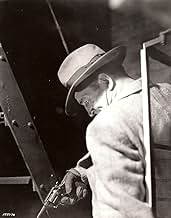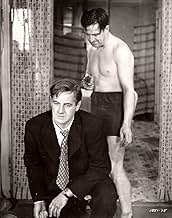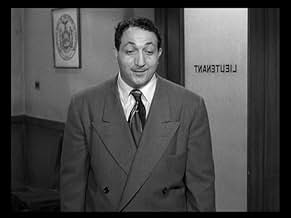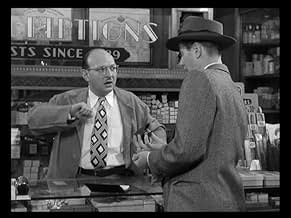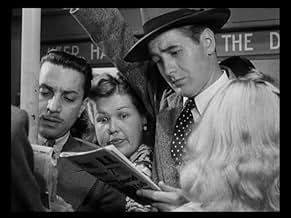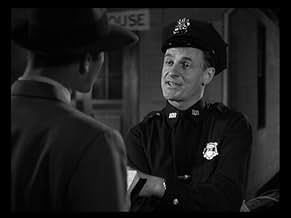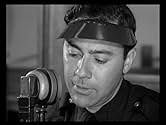IMDb रेटिंग
7.5/10
17 हज़ार
आपकी रेटिंग
न्यूयॉर्क की सड़कों पर हत्या की जांच पर एक कदम-दर-चरण नज़र।न्यूयॉर्क की सड़कों पर हत्या की जांच पर एक कदम-दर-चरण नज़र।न्यूयॉर्क की सड़कों पर हत्या की जांच पर एक कदम-दर-चरण नज़र।
- 2 ऑस्कर जीते
- 6 जीत और कुल 5 नामांकन
Ted de Corsia
- Willy Garzah
- (as Ted De Corsia)
Mark Hellinger
- Narrator
- (वॉइस)
Jean Adair
- Little Old Lady
- (बिना क्रेडिट के)
Celia Adler
- Dress Shop Proprietress
- (बिना क्रेडिट के)
Janie Alexander
- Girl
- (बिना क्रेडिट के)
Joyce Allen
- Shopgirl
- (बिना क्रेडिट के)
Beverly Bayne
- Mrs. Stoneman
- (बिना क्रेडिट के)
फ़ीचर्ड समीक्षाएं
This is a real original and just about everybody involved knows it. A documentary style police drama with real New York locations -- "Nothing was shot in a studio!" And it does capture New York City, circa 1947, entering a late florescent age. Many of the shots were "stolen," taken on real streets from a van with tinted windows, with only the principal actors knowing that a movie was being made.
White collar workers all wear suits and ties. There is a sidewalk salesman hawking neckties. An ice man with those over-sized calipers. A milkman driving a horse and wagon. A Kosher Deli. Little girls playing jump rope -- "Out goes the doctor, out goes the nurse, out goes the lady with the alligator purse." Kids on swings. People reading newspapers over someone else's shoulder while jolting along on the subway. A shootout on a tower of the Williamsberg Bridge. A blind man and his dog. Stillman's Gym with two professional wrestlers being coached in how to register pain. Two girls gawking at a wedding dress in a shop window and mooning over "Frankie." Ethnic people -- Italians, Irish, Jewish, Polish. Accents -- "A boxer-fighter maybe? What do I know?" "Eh, bene, bene -- encore." Scrubby walnut trees in brick-strewn vacant lots. Working class accents mostly, including that of the narrator, Mark Hellinger. Nobody is black or Puerto Rican. The taxi drivers speak English. No bums or dopers. It's all here, or rather it was all there.
Now, of course, it's all a little familiar because we've gotten used to location shooting and wince when shots are obviously studio made. But this was new at the time and is still enjoyable to watch.
The performances are adequate. Don Taylor is bland and doesn't have any accent but he's easy to identify with, at least for me, because he's so pleasant and handsome. Barry Fitzgerald has an oddly creased face and crudely shaped cranium. His smile is almost a mile wide, a caricature of itself, a lovable guy. Howard Duff is -- well, Howard Duff, a liar and a thief. Ted deCorsia is great. We first meet him working out in his shabby apartment, flexing and admiring himself in front of the mirror, his body pale and flabby, a shock of coarse black hair over his sweating forehead. And that voice, like a coffee grinder. And check out the list of supporting actors. Wow. Arthur O'Connell, Nehemia Persoff, James Gregory, inter alia.
The story itself isn't very much. Rather routine. Could have been a good radio drama of the sort that were popular at the time -- "Suspense" or "The Whistler" or "Inner Sanctum." And the narrator's voice-over sometimes creaks at the joints as it strains for hard-boiled sonority -- "Yesterday she was just another pretty face. This morning she's the marmalade on everybody's toast." (That line kills me.)
And, I have to admit, that it paints a kind of pretty picture of police procedures. Barry Fitzgerald in particular is folksy, humorous, and compassionate. I kept waiting for him to remove his pipe and mutter, "Ego te absolvo." The police offices look too CLEAN. There are no dents in the wall from suspects having their heads slammed against it. Every surface seems too recently to have been painted. Suspects who shout angrily at their police interrogators and are obviously lying are just politely reasoned with. It was a time of relative civility. The dective's job is to maintain that civility. Like a doctor, he isolated the criminal who functions as a kind of disease. The city wasn't yet the vicious game preserve it was to become in the 60s. At the end, isolated, the murdere is perched high atop the Williamburg Bridge and there are minuscule dots in white below him, playing tennnis, oblivious to the presence of the "other."
In a neat little touch, the cops are examining the scene of the crime and have found a few stray long hairs. From behind, Fitzgerald leans over the rather mopey middle-aged neighbor on the couch an compares the hair sample to hers. She looks around in surprise. "Er, don't mind me," says Fitzgerald, "I was only admiring your lovely hair." The neighbor clutches her hands together with delight and gazes up at him with an adoring dimpled smile. Fitzgerald pauses a moment, clears his throat, and hurries away.
Well, okay. This might have been "gritty" at the time but now it's just an interesting picture, a little glossy maybe, but a lot of fun, and ahead of its time with that location shooting by Daniels.
White collar workers all wear suits and ties. There is a sidewalk salesman hawking neckties. An ice man with those over-sized calipers. A milkman driving a horse and wagon. A Kosher Deli. Little girls playing jump rope -- "Out goes the doctor, out goes the nurse, out goes the lady with the alligator purse." Kids on swings. People reading newspapers over someone else's shoulder while jolting along on the subway. A shootout on a tower of the Williamsberg Bridge. A blind man and his dog. Stillman's Gym with two professional wrestlers being coached in how to register pain. Two girls gawking at a wedding dress in a shop window and mooning over "Frankie." Ethnic people -- Italians, Irish, Jewish, Polish. Accents -- "A boxer-fighter maybe? What do I know?" "Eh, bene, bene -- encore." Scrubby walnut trees in brick-strewn vacant lots. Working class accents mostly, including that of the narrator, Mark Hellinger. Nobody is black or Puerto Rican. The taxi drivers speak English. No bums or dopers. It's all here, or rather it was all there.
Now, of course, it's all a little familiar because we've gotten used to location shooting and wince when shots are obviously studio made. But this was new at the time and is still enjoyable to watch.
The performances are adequate. Don Taylor is bland and doesn't have any accent but he's easy to identify with, at least for me, because he's so pleasant and handsome. Barry Fitzgerald has an oddly creased face and crudely shaped cranium. His smile is almost a mile wide, a caricature of itself, a lovable guy. Howard Duff is -- well, Howard Duff, a liar and a thief. Ted deCorsia is great. We first meet him working out in his shabby apartment, flexing and admiring himself in front of the mirror, his body pale and flabby, a shock of coarse black hair over his sweating forehead. And that voice, like a coffee grinder. And check out the list of supporting actors. Wow. Arthur O'Connell, Nehemia Persoff, James Gregory, inter alia.
The story itself isn't very much. Rather routine. Could have been a good radio drama of the sort that were popular at the time -- "Suspense" or "The Whistler" or "Inner Sanctum." And the narrator's voice-over sometimes creaks at the joints as it strains for hard-boiled sonority -- "Yesterday she was just another pretty face. This morning she's the marmalade on everybody's toast." (That line kills me.)
And, I have to admit, that it paints a kind of pretty picture of police procedures. Barry Fitzgerald in particular is folksy, humorous, and compassionate. I kept waiting for him to remove his pipe and mutter, "Ego te absolvo." The police offices look too CLEAN. There are no dents in the wall from suspects having their heads slammed against it. Every surface seems too recently to have been painted. Suspects who shout angrily at their police interrogators and are obviously lying are just politely reasoned with. It was a time of relative civility. The dective's job is to maintain that civility. Like a doctor, he isolated the criminal who functions as a kind of disease. The city wasn't yet the vicious game preserve it was to become in the 60s. At the end, isolated, the murdere is perched high atop the Williamburg Bridge and there are minuscule dots in white below him, playing tennnis, oblivious to the presence of the "other."
In a neat little touch, the cops are examining the scene of the crime and have found a few stray long hairs. From behind, Fitzgerald leans over the rather mopey middle-aged neighbor on the couch an compares the hair sample to hers. She looks around in surprise. "Er, don't mind me," says Fitzgerald, "I was only admiring your lovely hair." The neighbor clutches her hands together with delight and gazes up at him with an adoring dimpled smile. Fitzgerald pauses a moment, clears his throat, and hurries away.
Well, okay. This might have been "gritty" at the time but now it's just an interesting picture, a little glossy maybe, but a lot of fun, and ahead of its time with that location shooting by Daniels.
There are two styles of Film Noir. Fueled by writers like James M. Cain, Dashiell Hammett, and Raymond Chandler, the first style emerged in the 1940s and was characterized by a cynical, often witty tone; anti-heroes, dangerous women, and assorted criminal elements; and complex plots that emphasized betrayal and moral ambiguity. It was also photographed in a remarkable visual style that combined glossy production values with atmospheric emphasis on light and shadow--and films like THE MALTESE FALCON, THIS GUN FOR HIRE, MILDRED PIERCE, THE BLUE DAHLIA, and DOUBLE INDEMNITY remain great classics of their kind.
But after World War II public taste began to change. Things that could only be hinted at in earlier films could now be more directly stated, and as audiences clamored for a more gritty realism the glossy sophistication of 1940s Noir fell out of fashion. The result was a new style of Noir--photographed in a grainier way, more direct, more brutal, and even less sympathetic to its characters. And the 1948 THE NAKED CITY was among the first to turn the tide. The sophisticated gumshoe, slinky gun moll, and glossy production values were gone; this film felt more like something you might read in a particularly lurid "true detective" tabloid.
In an era when most films were shot on Hollywood backlots, THE NAKED CITY was actually filmed in New York--and while filmmakers could film with hidden cameras sound technology of the day posed a problem. But producer Mark Hellinger turned the problem into an asset: the film would be narrated, adding to the documentary-like style of the cinematography and story. (Hellinger performed the narrative himself, and his sharp delivery is extremely effective.) The story itself reads very much like a police report, following NYPD detectives as they seek to solve a dress model's murder.
For 1948 it was innovative stuff-but like many innovative films it falters a bit in comparison to later films that improved upon the idea. The direct nature of the plot feels slightly too direct, slightly too simple. The same is true of the performances, which have a slightly flat feel, and although Barry Fitzgerald gives a sterling performance he is very much a Hollywood actor whose style seems slightly out of step alongside the deadpan style of the overall cast. Even so, the pace and drive of the film have tremendous interest, and while you might find yourself criticizing certain aspects you'll still be locked into the movie right to the very end. Particularly recommended for Film Noir addicts, who will be fascinated to see the turning point in the style.
Gary F. Taylor, aka GFT, Amazon Reviewer
But after World War II public taste began to change. Things that could only be hinted at in earlier films could now be more directly stated, and as audiences clamored for a more gritty realism the glossy sophistication of 1940s Noir fell out of fashion. The result was a new style of Noir--photographed in a grainier way, more direct, more brutal, and even less sympathetic to its characters. And the 1948 THE NAKED CITY was among the first to turn the tide. The sophisticated gumshoe, slinky gun moll, and glossy production values were gone; this film felt more like something you might read in a particularly lurid "true detective" tabloid.
In an era when most films were shot on Hollywood backlots, THE NAKED CITY was actually filmed in New York--and while filmmakers could film with hidden cameras sound technology of the day posed a problem. But producer Mark Hellinger turned the problem into an asset: the film would be narrated, adding to the documentary-like style of the cinematography and story. (Hellinger performed the narrative himself, and his sharp delivery is extremely effective.) The story itself reads very much like a police report, following NYPD detectives as they seek to solve a dress model's murder.
For 1948 it was innovative stuff-but like many innovative films it falters a bit in comparison to later films that improved upon the idea. The direct nature of the plot feels slightly too direct, slightly too simple. The same is true of the performances, which have a slightly flat feel, and although Barry Fitzgerald gives a sterling performance he is very much a Hollywood actor whose style seems slightly out of step alongside the deadpan style of the overall cast. Even so, the pace and drive of the film have tremendous interest, and while you might find yourself criticizing certain aspects you'll still be locked into the movie right to the very end. Particularly recommended for Film Noir addicts, who will be fascinated to see the turning point in the style.
Gary F. Taylor, aka GFT, Amazon Reviewer
THE NAKED CITY is like watching a time capsule unfold of New York City in the late '40s--the cars, the subways, the bridges, the people bustling along busy streets totally unaware of filming (scenes were shot from cars with tinted windows and two-way mirrors), and at the center of it all is a rather routine detective story. But the difference is the style that director Jules Dassin gets out of his material, giving the drama a chance to build up the proper tension before the final shootout on city streets and bridges.
BARRY FITZGERALD is the detective with the very helpful sidekick DON TAYLOR, a young police officer from Queens who helps him track down the man responsible for the death of a pretty blonde in what the tabloids called "The Bathtub Murder". Both men are excellent as they follow a batch of clues to get to the bottom of the crime. HOWARD DUFF is also excellent as a man mixed up in the robberies, with DOROTHY HART as his unsuspecting sweetheart.
TED DeCORSIA, making his film debut, is the athletic villain, working out in his small apartment when detective Taylor finds him--but soon making his escape which leads to the film's most breathtaking moments of a dazzling chase that fills the last ten minutes with high tension suspense.
The crime itself is not that interesting, but the style used to tell the tale (with a voice-over narration telling us at the conclusion that this is just one story in a city of millions) is what makes it far superior to most detective stories. That and the fact that New York City is given the spotlight for location photography that really hits the mark.
BARRY FITZGERALD is the detective with the very helpful sidekick DON TAYLOR, a young police officer from Queens who helps him track down the man responsible for the death of a pretty blonde in what the tabloids called "The Bathtub Murder". Both men are excellent as they follow a batch of clues to get to the bottom of the crime. HOWARD DUFF is also excellent as a man mixed up in the robberies, with DOROTHY HART as his unsuspecting sweetheart.
TED DeCORSIA, making his film debut, is the athletic villain, working out in his small apartment when detective Taylor finds him--but soon making his escape which leads to the film's most breathtaking moments of a dazzling chase that fills the last ten minutes with high tension suspense.
The crime itself is not that interesting, but the style used to tell the tale (with a voice-over narration telling us at the conclusion that this is just one story in a city of millions) is what makes it far superior to most detective stories. That and the fact that New York City is given the spotlight for location photography that really hits the mark.
That's just what the producer, Mark Hellinger does. He tries to make it clear from the introduction that this is not your average movie. It is not. This entire production tries to accomplish one thing - authenticity. And for the most part, it succeeds.
Before I get to what's right about this movie, let me mention a few of the things that are wrong. Ted DeCorsia overacts. He always overacts. Howard Duff's character, Frankie Niles, is supposed to be a streetwise grifter. How the hell could he be dumb enough to get himself in as many pickles as he did. Anybody who has ever been around the block would know better than to lie to the cops about everything. Just lie about the important things and tell the truth when it won't hurt you. If this guy is a sociopath, he's the dumbest one in town. Although most of the accents are on the money, the incidental dialogue injected into some of the scenes sounds forced and phony. In fact, it sounds like Hollywood trying to sound like New York. Mark Hellinger's narration, by comparison, is not only authentic, it's practically Damon Runyonesque.
Now - what's right. Practically everything else. The location photography is the New York I remember as a kid. While I was watching some of the hot summer scenes downtown, I could practically smell the asphalt, melting tar, and garbage. Don Taylor's brick duplex in Queens was just the kind of house that every struggling family on the wrong side of Brooklyn aspired to.
I won't comment on the story except to say, it's an entirely believable crime story. I seem to remember Barry Fitzgerald playing a similar role in Union Station. Reminds one of the old days when most of the cops were Irish - and New York was really New York.
Before I get to what's right about this movie, let me mention a few of the things that are wrong. Ted DeCorsia overacts. He always overacts. Howard Duff's character, Frankie Niles, is supposed to be a streetwise grifter. How the hell could he be dumb enough to get himself in as many pickles as he did. Anybody who has ever been around the block would know better than to lie to the cops about everything. Just lie about the important things and tell the truth when it won't hurt you. If this guy is a sociopath, he's the dumbest one in town. Although most of the accents are on the money, the incidental dialogue injected into some of the scenes sounds forced and phony. In fact, it sounds like Hollywood trying to sound like New York. Mark Hellinger's narration, by comparison, is not only authentic, it's practically Damon Runyonesque.
Now - what's right. Practically everything else. The location photography is the New York I remember as a kid. While I was watching some of the hot summer scenes downtown, I could practically smell the asphalt, melting tar, and garbage. Don Taylor's brick duplex in Queens was just the kind of house that every struggling family on the wrong side of Brooklyn aspired to.
I won't comment on the story except to say, it's an entirely believable crime story. I seem to remember Barry Fitzgerald playing a similar role in Union Station. Reminds one of the old days when most of the cops were Irish - and New York was really New York.
In New York, the model Jean Dexter is found dead in the bathtub of her apartment apparently after committing suicide. However, the coroner concludes that she was actually murdered with a simulation of suicide. The experienced Homicide Lieutenant Detective Dan Muldoon (Barry Fitzgerald) initiates his investigations with Detective Jimmy Halloran (Don Taylor) and his team, and the prime suspect becomes Jean's friend Frank Niles (Howard Duff), who he an alibi but tells many lies in his statement.
The director Jules Dassin from the masterpiece "Du Rififi Chez Les Hommes" and "Night and the City" presents "The Naked City" totally filmed in locations of New York City and with actors interacting with common people on the streets like in the Italian Neo-Realism. The introduction is unique, with the credits narrated by the producer Mark Hellinger like in a documentary, and I do not recall any other movie with this characteristic. The screenplay discloses a great detective story, very well acted with Barry Fitzgerald playing a cynical and smart lieutenant and Don Taylor an inexperienced and family man detective. In the conclusion, the narrator tells that this is one of the 8,000,000 stories of the naked city, in a time where New York City had only this population (against more than 20 million inhabitants of the present days). My vote is eight.
Title (Brazil): "Cidade Nua" ("Naked City")
Note: On 27 May 2016, I saw this film again.
The director Jules Dassin from the masterpiece "Du Rififi Chez Les Hommes" and "Night and the City" presents "The Naked City" totally filmed in locations of New York City and with actors interacting with common people on the streets like in the Italian Neo-Realism. The introduction is unique, with the credits narrated by the producer Mark Hellinger like in a documentary, and I do not recall any other movie with this characteristic. The screenplay discloses a great detective story, very well acted with Barry Fitzgerald playing a cynical and smart lieutenant and Don Taylor an inexperienced and family man detective. In the conclusion, the narrator tells that this is one of the 8,000,000 stories of the naked city, in a time where New York City had only this population (against more than 20 million inhabitants of the present days). My vote is eight.
Title (Brazil): "Cidade Nua" ("Naked City")
Note: On 27 May 2016, I saw this film again.
क्या आपको पता है
- ट्रिवियाMost of the street scenes were shot on location in New York without the public's knowledge. Photographer William H. Daniels and his uncredited assistant Roy Tripp filmed people on the streets using a hidden camera from the back of an old moving van. Occasionally, a fake newsstand with a hidden camera inside was also set up on the sidewalk to secretly film the actors. Director Jules Dassin hired a juggler to distract the crowds and also hired a man to occasionally climb up on a light post and give a patriotic speech, while waving an American flag to get the crowd's attention.
- गूफ़During the end pursuit, Garzah walks past a plump, dark-haired lady in a floral dress, pushing a baby in a stroller. As Donahue pursues in a following scene, he passes the same woman, now walking without her baby carriage and her left hand bandaged.
- क्रेज़ी क्रेडिटThe opening credits are spoken by producer/narrator Mark Hellinger. No credits are seen on the screen.
- कनेक्शनFeatured in The Movie Orgy (1968)
- साउंडट्रैकSobre las Olas (Over the Waves)
(1887) (uncredited)
Written by Juventino Rosas
Background music for the girls on swings
टॉप पसंद
रेटिंग देने के लिए साइन-इन करें और वैयक्तिकृत सुझावों के लिए वॉचलिस्ट करें
- How long is The Naked City?Alexa द्वारा संचालित
विवरण
- रिलीज़ की तारीख़
- कंट्री ऑफ़ ओरिजिन
- भाषा
- इस रूप में भी जाना जाता है
- La ciudad desnuda
- फ़िल्माने की जगहें
- उत्पादन कंपनियां
- IMDbPro पर और कंपनी क्रेडिट देखें
बॉक्स ऑफ़िस
- US और कनाडा में सकल
- $24,00,000
- चलने की अवधि
- 1 घं 36 मि(96 min)
- रंग
- पक्ष अनुपात
- 1.37 : 1
इस पेज में योगदान दें
किसी बदलाव का सुझाव दें या अनुपलब्ध कॉन्टेंट जोड़ें


